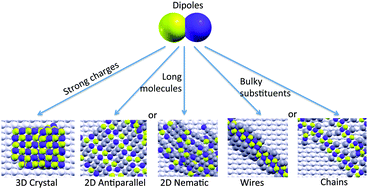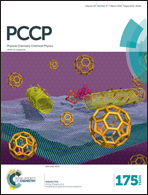Fundamental aspects in surface self-assembly: theoretical implications of molecular polarity and shape†
Abstract
We investigate fundamental aspects of structure formation in molecular self-assembly, by examining the emergence of order upon adsorption of a series of model molecules. It is known that strongly polar diatomic molecules form three-dimensional crystals in the absence of a substrate. This tendency can be disrupted upon assembly on a solid surface, and various other types of order may arise. Depending on the relative strength of the interactions, disordered phases, two-dimensional crystals commensurate to the surface, and unmodified crystals were observed upon adsorption of simple dipoles in the present work. Introduction of steric features, in the form of a longer backbone or substituents external to the polar pair, led to even richer phase diagrams. The formation of two-dimensional phases with nematic (parallel) or antiparallel alignment was accomplished by altering the polarity of the end groups on needle-like molecules, whereas embedded charged groups made two-dimensional structure unstable for even very long molecules. These molecules preferred to align in long, often desorbed, molecular wires. The wealth of phases observed here parallel the results of experimental systematic or incidental studies of the relationships between molecular interactions and self-assembled patterns, and provide some insight into the molecular handles that self-assembly researchers can wield to guide the process towards a desired structural outcome.


 Please wait while we load your content...
Please wait while we load your content...